Related Research Articles
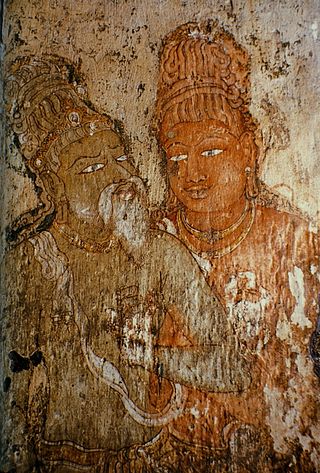
Rajaraja I, also known as Rajaraja the Great, was a Chola emperor who reigned from 985 CE to 1014 CE. He is known for his conquests of South India and parts of Sri Lanka, and increasing Chola influence across the Indian Ocean.

Kulottunga Chola I also spelt Kulothunga, born Rajendra Chalukya, was a Chola Emperor who reigned from 1070 to 1122 succeeding his cousin Athirajendra Chola. He also served as the Eastern Chalukya monarch from 1061 to 1118, succeeding his father Rajaraja Narendra. He is related to the Chola dynasty through his mother's side and the Eastern Chalukyas through his father's side. His mother, Ammangaidevi, was a Chola princess and the daughter of emperor Rajendra Chola I. His father was king Rajaraja Narendra of the Eastern Chalukya dynasty who was the nephew of Rajendra and maternal grandson of Rajaraja Chola I. According to historian Sailendra Nath Sen, his accession marked the beginning of a new era and ushered in a period of internal peace and benevolent administration. He was succeeded by his son Vikrama Chola
Rajendra I, often referred to as Rajendra the Great, Gangaikonda Cholan, and Kadaram Kondan, was a Chola Emperor who reigned from 1014 and 1044 CE. He was born in Thanjavur to Rajaraja I and his queen Vanavan Mahadevi and assumed royal power as co-regent with his father in 1012 until his father died in 1014, when Rajendra ascended to the Chola throne. During his reign, the Chola Empire reached its zenith in the Indian subcontinent; it extended its reach via trade and conquest across the Indian Ocean, making Rajendra one of only a few Indian monarchs who conquered territory beyond South Asia.
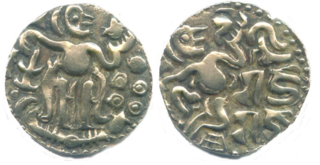
Rajadhiraja Chola I was a Chola emperor, as the successor of his father, Rajendra I. He was the only Chola emperor who was killed while leading his army in war, and although he had a short reign, he helped his father conquer several territories as well as to maintain the Chola authority over most of Sri Lanka, Eastern Chalukya and Kalinga, among others. He also established imperial relations with overseas allies despite a series of revolts in the territory.

The Chola dynasty was a Tamil dynasty originating from southern India. At its height, it ruled over the Chola Empire, an expansive maritime empire. The earliest datable references to the Chola are from inscriptions dated to the 3rd century BCE during the reign of Ashoka of the Maurya Empire. The Chola empire was at its peak and achieved imperialism under the Medieval Cholas in the mid-9th century CE. As one of the Three Crowned Kings of Tamilakam, along with the Chera and Pandya, the dynasty continued to govern over varying territories until the 13th century CE.

Rajendra Chola II often referred to as Rajendradeva Chola was a Chola emperor who reigned from 1052 CE to 1064 CE. Rajendra II succeeded his brother Rajadhiraja I after his death at the Battle of Koppam. Rajendra had served as a Co-regent under his brother from 1044 CE to 1052 CE. When he acceded the throne, the Chola Empire was at its peak stretching from Southern India to Vengai(Bengal) to parts of Southeast Asia. Rajendra had maintained the territories of his predecessor. During his reign, the Chola Empire was prosperous and had a large influence in trade throughout the Indian Ocean.

The Chola Empire, which is often referred to as the Imperial Cholas, was a medieval thalassocratic empire based in southern India that was ruled by the Chola dynasty, and comprised overseas dominions, protectorates and spheres of influence in southeast Asia.

Vikrama Chola, known as Kō Parakēsari Varman, was a 12th-century ruler of the Chola Empire in southern India. He succeeded his father Kulothunga I to the throne. Vikrama Chola was crowned as the heir-apparent by his father early in his life. He was appointed as viceroy of the Vengi province in 1089 C.E., succeeding his brother Rajaraja Chodaganga. Vikrama during his tenure successfully managed to check the ambitions of the Western Chalukya Vikramaditya VI on the Vengi kingdom.Vikrama Chola inherited the territories which included Tamil Nadu and some parts of Andhra Pradesh.

Kulothunga III was a Chola emperor who ruled from 1178 to 1218 CE, after succeeding his elder brother Rajadhiraja II. Kulothunga Chola III gained success in war against his traditional foes. He gained victories in war against the Hoysalas, Pandyas of Madurai, Cheras of Venad, the Sinhalese kings of Polonnaruwa, as well as the Telugu Cholas of Velanadu and Nellore. He also restored Chola control over Karur, which were ruled by the Adigaman chiefs as vassals of the Cholas. He drove out the Hoysalas under Veera Ballala II who had made inroads in the Gangavadi and adjoining areas of Tagadur in Kongu country in an effort expand their territory. However, during the last two years of his reign, he lost in war to the resurgent Pandyas, heralded a period of steady decline and ultimately, demise of the Cholas by 1280 CE. Kulottunga III had alliances with the Hoysalas. The Hoysala king Veera Ballala married a Chola queen called Cholamahadevi and gave his daughter Somaladevi in marriage to Kulottunga III.
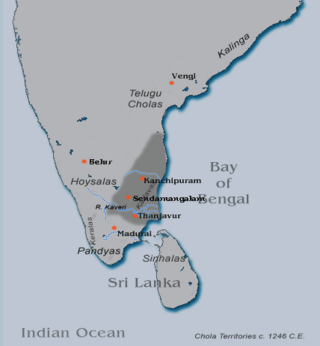
Rajaraja Chola III succeeded Kulothunga Chola III on the Chola throne in July 1216 CE. Rajaraja came to the throne of a kingdom much reduced in size as well as influence. With the rise of the Pandya power in the south, the Cholas had lost most of their control of the territories south of the river Kaveri and their hold on the Vengi territories in the north was slipping with the emergence of the Hoysala power.

The Chola military was the combined armed forces of the Chola Empire organized during two separate Tamil golden ages, the Sangam Period and the Medieval Era. The Chola military fought dozens of wars, and it also underwent numerous changes in structure, organization, equipment and tactics, while conserving a core of lasting Tamil traditions.

Rajaraja Narendra was an Eastern Chalukya king of the Vengi kingdom in present-day Andhra Pradesh. He founded the city of Rajahmahendravaram (Rajahmundry), and his reign is noted for its significant contributions to social and cultural heritage. Narendra requested his teacher, advisor, and court poet Nannayya to translate the Mahabharata into Telugu as Andhra Mahabharatam.
Kadava was the name of a Tamil ruling dynasty who ruled parts of the Tamil country during the thirteenth and the fourteenth century. Kadavas were related to the Pallava dynasty and ruled from Kudalur near Cuddalore in Tamil Nadu. Hiranyavarman, the father of Nandivarman II Pallavamalla is said to have belonged to the Kadavakula in epigraphs. Nandivarman II himself is described as "one who was born to raise the prestige of the Kadava family". Chiefs bearing the Kadava title figure as feudatories of the Cholas as early as the 12th century. During the reign of Kulothunga Chola II, there was a vassal called Alappirandan Elisaimohan alias Kulottungasola Kadavaradittan. The Kadava kingdom was at the height of their power briefly during the reigns of Kopperunchinga I and Kopperunchinga II. These two rulers were powerful enough to challenge the waning Chola dynasty during the reign of Rajaraja Chola III and Rajendra Chola III. The two Kopperunchingas have left a large number of inscriptions mostly in the North and South Arcot districts and in the Chengalpattu district.

Ottakoothar was a Tamil court poet and minister to three Later Chola kings, namely Vikrama Chola, Kulotunga II and Rajaraja II. He wrote poems in praise of these three kings.
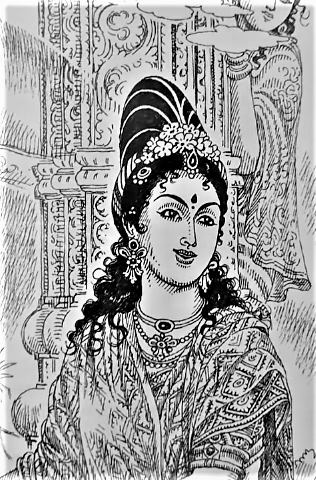
Kundavai Pirattiyar, commonly known mononymously as Kundavai, was a Chola Indian princess who lived in the tenth century in South India. She was the daughter of Parantaka II and Vanavan Mahadevi. She was born in Tirukoilur and was the elder sister of Chola emperor Rajaraja I. She had title as Ilaiyapirātti Kundavai Nachiyar.
The Chola Navy was composed of ships used for transporting the land army overseas.The Cholas did not have a standing navy in the modern sense. The maritime force of Cholas was formed by using ships used for trade, as they did not have a dedicated ship for naval combat.
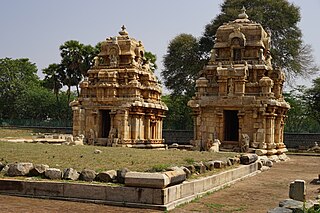
Irunkōvēl, also known as Irungkōvēl, Irukkuvēl, and Ilangōvēlir, was a title of the Irunkōvēl line of Velir kings. The Irunkovel line of kings ruled over Konadu identified with the Kodumbalur and surrounding areas in ancient Tamilakkam. They trace their lineage to the clan of Krishna; one of the inscriptions at Kodumbalur belonging to one of the kings in the Irunkovel line, namely Tennavan Irunkōvēl alias Maravan Bhutiyar. They belong to Kallar family, K. A. Nilakanta Sastri mentions in his study.
The Mutharaiyar was a south Indian dynasty that ruled as kings of Thanjavur, Sivaganga, Trichy, Pudukottai, Perambalur,Thiruvarur regions between 600 and 850 CE.
Sanatkumara Chakravarti is the 4th Chakravarti of present Avasarpiṇī of the Jain cosmology.
Manimangalam is a small town located in the Kanchipuram district of Tamil Nadu state in Southern India, famous for its ancient temples and inscriptions documenting the history of the ancient Tamil kings
References
- ↑ M. S. Govindasamy. The role of feudatories in later Chōḷa history. Annamalai University, 1979 - Chola (Indic people) - 325 pages. p. 263.
- ↑ Kallidaikurichi Aiyah Nilakanta Sastri. The Cōḷas, Volume 2, Issue 2. University of Madras, 1937 - Chola (Indic people). p. 643.
- ↑ S. Sankaranarayanan, S. S. Ramachandra Murthy, B. Rajendra Prasad, D. Kiran Kranth Choudary. Śāṅkaram: recent researches on Indian culture : Professor Srinivasa Sankaranarayanan festchrift. Harman Pub. House, 2000. p. 119.
{{cite book}}: CS1 maint: multiple names: authors list (link) - ↑ Mythic Society (Bangalore, India). The Quarterly Journal of the Mythic Society (Bangalore, India)., Volume 85. The Society, 1994. p. 70.
- ↑ Ramesh Chandra Majumdar, Achut Dattatrya Pusalker, A. K. Majumdar, Dilip Kumar Ghose, Vishvanath Govind Dighe, Bharatiya Vidya Bhavan. The History and Culture of the Indian People: The struggle for empire.-2d ed, Volume 5 of The History and Culture of the Indian People, Achut Dattatrya Pusalker. Bharatiya Vidya Bhavan, 1966. p. 165.
{{cite book}}: CS1 maint: multiple names: authors list (link) - ↑ History Of Ancient India (portraits Of A Nation), By Kapur, Kamlesh, p.613
- ↑ Irāmaccantiran̲ Nākacāmi, Tamil Nadu (India). Dept. of Archaeology. Thiruttani and Velanjeri copper plates. State Dept. of Archaeology, Govt. of Tamil Nadu, 1979 - History - 34 pages. p. 10.
- ↑ South Indian Inscriptions Vol 41. 2019. p. 302.